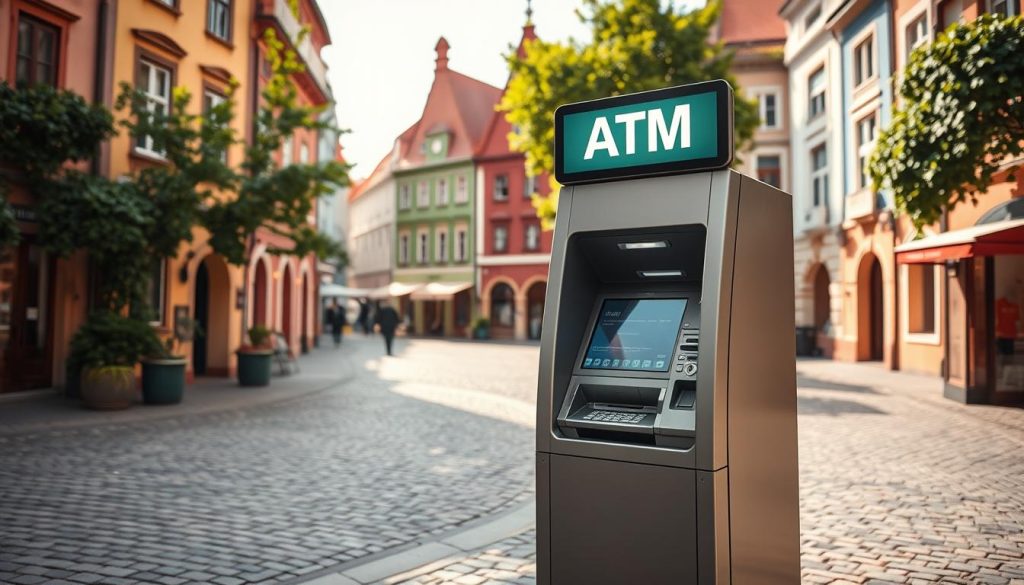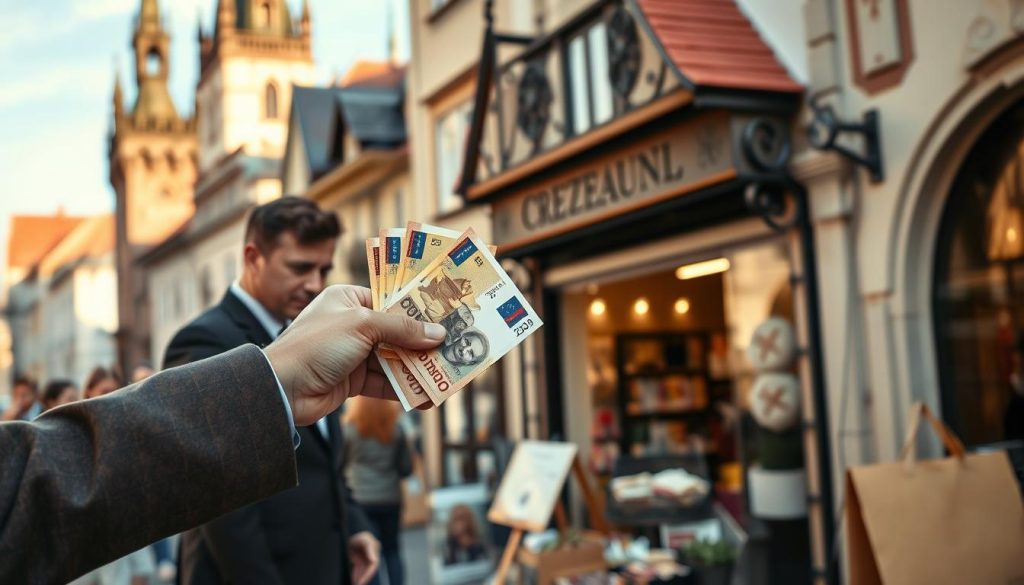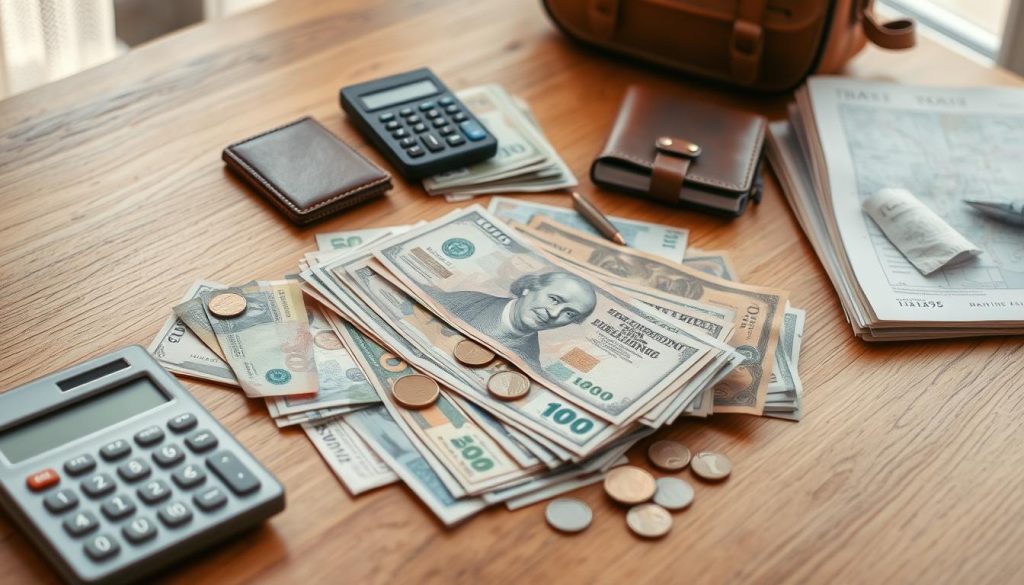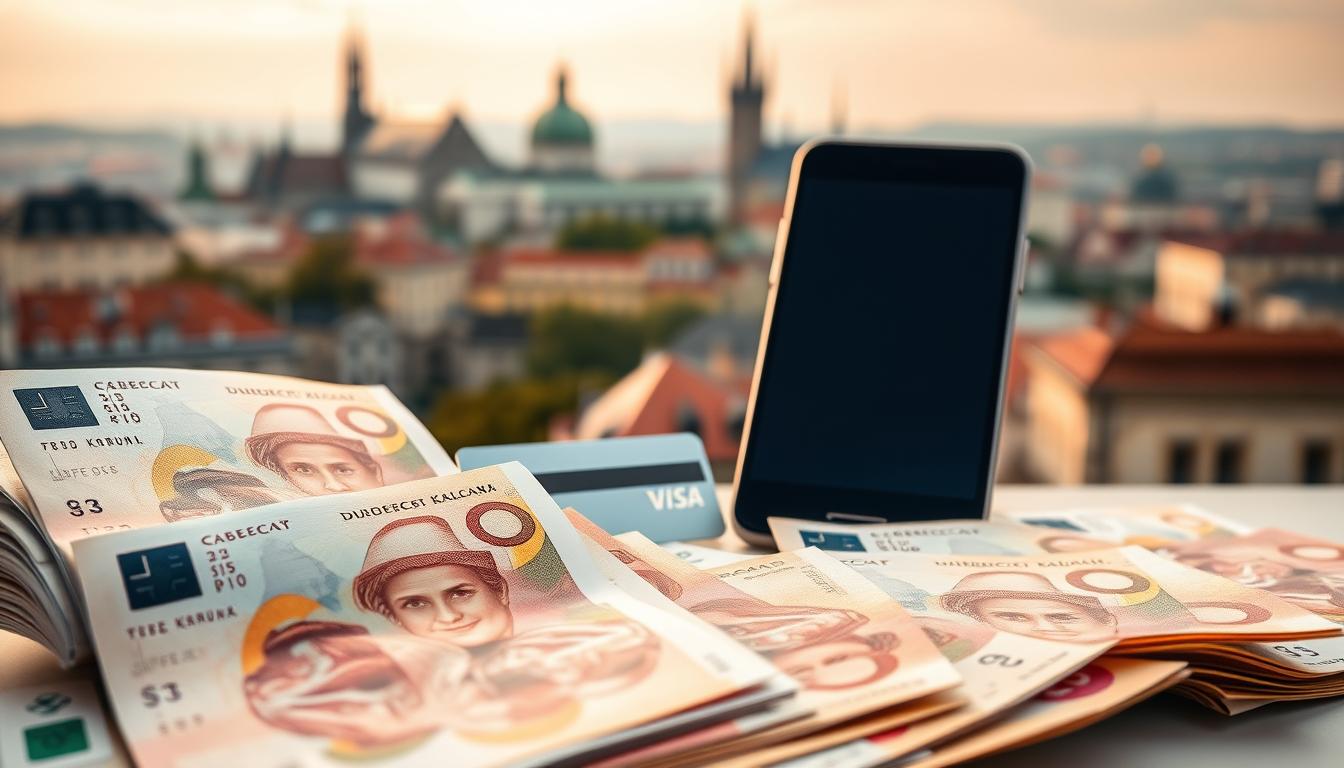✓ Accommodations✓ Flights✓ Rental Cars✓ Tours & Activities
Did you know that over 10 million tourists visit the Czech Republic each year? This stunning country, known for its historic cities like Prague and Brno, operates on the Czech Koruna (CZK). Understanding the local currency and payment options is essential for a smooth trip.
Locals like Adriana and Matěj emphasize the importance of knowing where to exchange money and how to avoid scams. Reliable ATMs and trusted banks are your best allies. Always opt for ATMs with bank logos to avoid unfavorable exchange rates and high fees.
This guide will walk you through everything you need to know about exchange rates, using cards versus cash, and navigating transactions in shops, restaurants, and hotels. Whether you’re exploring the Old Town Square or Wenceslas Square, you’ll be prepared to handle your money wisely.
Written in American English, this guide is tailored for U.S. travelers seeking clear, practical advice. Let’s make your trip to the Czech Republic as seamless as possible!
Introduction to Czech Currency
Planning a trip to the Czech Republic? Understanding the local currency is your first step. The official currency is the Czech Koruna (CZK), often referred to as the Czech Crown. Despite being a member of the European Union, the country does not use the euro, which can be a surprise for some visitors.
Cash is still widely used in many places, especially in smaller shops, local restaurants, and rural areas. While cards are accepted in larger cities like Prague, having some cash on hand ensures you’re prepared for any situation. This is particularly useful when exploring popular spots like Old Town Square or Wenceslas Square.
The Czech Koruna comes in both coins and banknotes, with values ranging from small denominations to larger bills. Knowing the basics of the currency helps you avoid scams and unfavorable exchange rates. For example, always check the exchange rate before converting your money, and opt for trusted banks or ATMs.
Understanding the local currency not only makes transactions smoother but also helps you appreciate the value of goods and services. Whether you’re shopping, dining, or paying for a guided tour, being familiar with the CZK ensures you get the most out of your trip.
Understanding the Czech Koruna
The Czech Koruna is more than just money—it’s a piece of the country’s identity. Known as the Czech Crown, this currency has been in use since 1993. Despite being part of the European Union, the Czech Republic has kept its own currency, making it unique among EU members.
The Koruna comes in both coins and banknotes. Coins are available in denominations of 1, 2, 5, 10, 20, and 50 CZK. Each coin features distinct designs, often highlighting Czech history and culture. Banknotes range from 100 CZK to 5,000 CZK, with each value having a unique size and color for easy identification.
| Denomination | Type | Design Feature |
|---|---|---|
| 1 CZK | Coin | St. Wenceslas Crown |
| 10 CZK | Coin | Charles Bridge |
| 100 CZK | Banknote | King Charles IV |
| 500 CZK | Banknote | Božena Němcová |
Prices in the Czech Republic are often displayed with haléř values, such as 9.99 CZK. However, haléř coins are no longer in circulation. Amounts above 0.50 CZK are rounded up to the nearest crown during transactions.
Understanding the Koruna’s design and denominations will make your transactions smoother. Whether you’re shopping in Prague’s Old Town Square or dining in Wenceslas Square, you’ll feel confident handling the local currency.
Knowing the exchange rate is also crucial. For example, 100 CZK is roughly equivalent to $5 USD. Keep this in mind when budgeting for your trip. With these tips, you’ll master the Czech Koruna in no time!
ATMs and Local Banking Options
Navigating ATMs in the Czech Republic can be a breeze if you know where to look. With over 6,000 ATMs across the country, accessing cash is convenient. However, not all machines are created equal. Choosing the right one can save you time and money.

Finding Reliable Bank ATMs
Local bank ATMs are your best bet for fair exchange rates and low fees. Stick to reputable banks like KBC, Erste, Komerční Banka, and Česká Spořitelna. These institutions are known for their transparency and reliability.
When withdrawing money, always check for the bank’s logo on the machine. Avoid standalone ATMs in tourist-heavy areas like Old Town Square or Wenceslas Square. These often charge higher fees and offer unfavorable rates.
Avoiding High Commission Machines
Tourist-targeted ATMs, such as those operated by Euronet, can charge commissions as high as 35%. These machines are often found in busy areas but are best avoided. Always read the fee disclosure before proceeding with a transaction.
Here’s a quick tip: Select to pay withdrawal fees in local currency (CZK) to avoid additional charges. This simple step can save you money and ensure a smoother experience.
By sticking to trusted bank ATMs and being mindful of fees, you can make the most of your money while exploring the Czech Republic. Whether you’re in Prague or a smaller city, these tips will help you navigate ATMs with confidence.
Avoiding Common Currency Exchange Scams
Exchanging money in the Czech Republic can be tricky if you’re not prepared. While most exchange offices are legitimate, some target tourists with unfair rates and hidden fees. Knowing how to spot these scams can save you both money and frustration.
Recognizing Red Flags at Exchange Offices
Be cautious of signs like “0% commission” or “best rates in town.” These are often used by fraudulent operators to lure unsuspecting visitors. Look for blue signs with a flower or red signage, as these are common indicators of suspicious offices.
Another red flag is the absence of a clear exchange rate display. Legitimate offices will always show their rates prominently. If the rate seems too good to be true, it probably is.
Tips to Spot Unfavorable Exchange Rates
Always verify the internationally accepted exchange rate before converting your money. For example, 1 EUR should be around 25 CZK. If the rate offered is significantly lower, walk away.
Check the spread between the buy and sell rates. A large gap indicates unfair practices. Additionally, ask about any hidden fees or commissions before proceeding with the transaction.
| Red Flag | What to Do |
|---|---|
| “0% commission” signs | Avoid these offices; they often have hidden fees. |
| No rate display | Always choose offices with clear rate information. |
| Blue signs with a flower | These are often linked to fraudulent operators. |
| Too good to be true rates | Verify the rate against the international standard. |
By following these tips, you can protect yourself from losing value during your trip. Stick to trusted banks or ATMs for the best rates and avoid high-traffic tourist areas for exchanges.
Choosing the Right Exchange Office
Planning your trip to the Czech Republic? Finding the best place to exchange money doesn’t have to be stressful. With a little guidance, you can avoid scams and get the most value for your cash.
When selecting an exchange office, transparency is key. Look for places that clearly display their rates and fees. Avoid offices with signs like “0% commission,” as these often have hidden charges. Trusted locations near Wenceslas Square and Old Town Square, such as Huspak and Alfa Prague, are known for their fair rates.
Exchanging larger sums at once can often secure a better exchange rate. For example, converting $500 instead of $100 may save you on fees. Always compare the displayed “spread” (the difference between buy and sell rates) with the Czech National Bank’s standards to ensure fairness.
Street exchanges are risky and should be avoided. Stick to reputable offices or banks for your transactions. Banks like Komerční Banka and Česká Spořitelna offer reliable services with clear policies.
Here’s a quick tip: Verify the exchange rate before proceeding. For instance, 1 EUR should be around 25 CZK. If the rate seems off, walk away. By following these steps, you’ll feel confident handling your money in the Czech Republic.
Cards vs. Cash: Payment Best Practices
When traveling in the Czech Republic, deciding between cards and cash can make a big difference. Both options have their pros and cons, and knowing when to use each can save you time and money. Whether you’re exploring Prague’s Old Town Square or dining in Wenceslas Square, here’s what you need to know.
Pros and Cons of Card Transactions
Using credit or debit cards is convenient and secure. Most restaurants, shops, and museums in Prague accept cards, making them a reliable option. Cards also reduce the need to carry large amounts of cash, which can be safer in busy areas.
However, be aware of potential fees. Some banks charge foreign transaction fees, which can add up. Dynamic currency conversion, where the exchange rate is set by the merchant, often comes with higher costs. Always opt to pay in the local currency (CZK) to avoid these fees.
When to Keep Cash on Hand
While cards are widely accepted, cash is still essential in certain situations. Small shops, market stalls, and public transport often require cash payments. Having some CZK on hand ensures you’re prepared for these transactions.
For example, if you’re visiting rural areas or local markets, cash is the preferred payment method. It’s also useful for tipping at restaurants or paying for small services like guided tours.
| Payment Method | Best For | Things to Watch Out For |
|---|---|---|
| Cards | Restaurants, shops, hotels | Foreign transaction fees, dynamic currency conversion |
| Cash | Small vendors, public transport, tips | Exchange rates, carrying large amounts |
Travel debit cards like Revolut or Wise can help you save on fees. These cards allow you to convert and store funds in CZK at competitive rates. They’re also widely accepted, making them a great alternative to traditional bank cards.
By balancing card and cash usage, you’ll navigate payments in the Czech Republic with ease. Whether you’re shopping, dining, or exploring, these tips will help you make the most of your money.
Czechia: Ultimate Travelers Guide to Currencies & Payments
Exploring the Czech Republic’s currency system can enhance your travel experience. This guide has covered everything from understanding the Czech Koruna (CZK) to navigating ATMs and avoiding scams. Whether you’re in Prague or a smaller city, being informed ensures smooth transactions and better value for your money.
We’ve highlighted the importance of using trusted bank ATMs and avoiding high-fee machines. Always check the exchange rate before converting your currency. This simple step can save you from unfavorable rates and hidden fees.
Cash is still widely used, especially in smaller shops and rural areas. However, cards are accepted in most restaurants, hotels, and larger stores. Balancing both payment methods ensures you’re prepared for any situation.
This guide is designed to be your go-to resource before and during your trip. It combines practical advice with insider tips to help you save money and avoid common pitfalls. From Old Town Square to Wenceslas Square, you’ll feel confident handling your finances.
Stay tuned for upcoming sections that dive deeper into specific payment scenarios and travel tips. Whether you’re dining out, shopping, or exploring, this guide has you covered. Safe travels and happy spending in the Czech Republic!
Payment Practices in Restaurants and Hotels
Understanding payment practices in the Czech Republic can make dining and hotel stays hassle-free. Whether you’re enjoying a meal in Prague or checking into a hotel in a smaller city, knowing your options ensures a smooth experience.
Selecting the Best Payment Method at Dining Venues
Most restaurants in the Czech Republic accept credit and debit cards, especially in tourist-heavy areas like Old Town Square and Wenceslas Square. Cards are convenient and reduce the need to carry large amounts of cash. However, smaller venues or local eateries may prefer cash, so it’s wise to have some CZK on hand.
When using cards, always opt to pay in the local currency to avoid dynamic currency conversion fees. This simple step can save you money on every transaction. Additionally, check with your bank about foreign transaction fees to avoid surprises.
Understanding Minimum Purchase Requirements
Some smaller shops or market stalls may require a minimum purchase for card payments, often around 200 CZK. This is common in rural areas or less touristy spots. If you’re planning to make small purchases, carrying cash is your best bet.
For larger purchases, cards are usually the better option. They offer security and convenience, especially when traveling. Just be mindful of the exchange rate and any additional fees your bank might charge.
Tipping is another important aspect of dining in the Czech Republic. A standard tip of 10-15% is appreciated, though some restaurants include a service charge. Always check your bill to avoid double-tipping.
By balancing card and cash usage, you’ll navigate payments in restaurants and hotels with ease. Whether you’re dining out or checking into your accommodation, these tips will help you make the most of your money.
Withdrawing Local Currency on Arrival
Arriving in the Czech Republic? Getting local currency right away is a smart move. Having Czech Koruna (CZK) in hand ensures you’re prepared for immediate expenses like transport, food, or tips. While cards are widely accepted, cash is still essential for smaller transactions.
Airport exchange kiosks are convenient but often charge higher fees and offer less favorable rates. Instead, use ATMs located in the city or at trusted banks. This approach saves you money and gives you better value for your currency exchange.

When withdrawing cash, stick to well-known bank ATMs like Komerční Banka or Česká Spořitelna. These machines are reliable and offer fair exchange rates. Avoid standalone ATMs in tourist-heavy areas, as they often come with hidden fees.
Here are some safety tips for withdrawing cash upon arrival:
- Choose ATMs inside banks or secure locations.
- Check for skimming devices before inserting your card.
- Withdraw larger amounts to minimize transaction fees.
- Always verify the mid-market rate before proceeding.
Using ATMs instead of airport kiosks can save you significantly. For example, withdrawing 5000 CZK at a bank ATM might cost you $5 in fees, while an airport kiosk could charge $20 or more. This simple step ensures you get the most out of your money.
| Option | Pros | Cons |
|---|---|---|
| Bank ATMs | Fair rates, low fees, secure | May require a short trip from the airport |
| Airport Kiosks | Convenient, immediate access | Higher fees, unfavorable rates |
By following these tips, you’ll start your trip on the right foot. Whether you’re heading to Old Town Square or exploring Wenceslas Square, having local cash ensures a smooth and stress-free experience.
Utilizing Travel Debit Cards Effectively
Travel debit cards can be a game-changer for your trip to the Czech Republic. They offer low fees, real-time currency conversions, and convenience, making them a smart choice for managing your money abroad.
When selecting a travel debit card, look for providers like Wise or Revolut. These cards use the mid-market exchange rate, which is often better than traditional bank rates. This means you get more value for your money when converting funds to CZK.
- Activate your card before your trip. Ensure it’s ready for international use and linked to your account.
- Convert funds in advance. Many cards allow you to store multiple currencies, including CZK, at competitive rates.
- Avoid dynamic currency conversion. Always choose to pay in the local currency to dodge extra fees.
Travel debit cards also simplify transactions in shops, restaurants, and hotels. For example, in Prague’s Old Town Square, you can pay with ease while avoiding high fees from traditional bank cards.
By using a travel debit card, you’ll save money and enjoy a smoother experience. Whether you’re exploring Wenceslas Square or dining in a local restaurant, these tips ensure you’re always prepared.
Monitoring Exchange Rates and Fees
Keeping an eye on exchange rates can save you money during your trip. Daily fluctuations in currency values can impact your spending, so staying updated is essential. Whether you’re dining in a restaurant or shopping in Old Town Square, knowing the current rate ensures you get the best value for your money.
Using Currency Converter Apps
Currency converter apps like XE are invaluable tools for travelers. These apps provide real-time exchange rate updates, helping you make informed decisions. For example, if you’re converting USD to CZK, you can instantly check the rate before making a transaction.
Here’s why these apps are useful:
- They offer accurate, up-to-date information.
- You can track multiple currencies simultaneously.
- They help you avoid unfavorable rates at exchange offices.
Comparing Mid-Market Rates
The mid-market rate is the real exchange rate used in global markets. Banks and ATMsoften add a markup to this rate, increasing your costs. By comparing the mid-market rate with the offered rate, you can identify fair deals.
For instance, if the mid-market rate is 25 CZK per 1 EUR, but a bank offers 23 CZK, you’re losing value. Always verify rates before exchanging money to avoid unnecessary fees.
“Small differences in exchange rates can add up quickly. Being digitally savvy with these tools can lead to significant savings.”
| Tool | Benefit |
|---|---|
| XE Currency Converter | Real-time rate tracking |
| Mid-Market Rate Comparison | Identifies fair exchange rates |
| Bank ATMs | Lower fees, better rates |
Monitoring fees is equally important. Some banks charge foreign transaction fees, while others offer fee-free withdrawals. By choosing the right card and ATM, you can minimize costs and maximize your travel budget.
For example, withdrawing 5000 CZK at a trusted bank ATM might cost $5 in fees, while an airport kiosk could charge $20. These small savings add up, especially for longer trips.
By staying informed and using the right tools, you’ll navigate currency exchange with confidence. Whether you’re in Prague or a smaller city, these tips ensure you get the most out of your money.
Cash Payment Tips for Czech Cities
Exploring Czech cities? Cash is still king in many places. While cards are widely accepted in larger cities like Prague, smaller shops, markets, and rural areas often prefer cash. Knowing how to manage your CZK ensures smooth transactions and better value for your money.

Here’s how much cash to carry: For a day in Prague, around 1000-2000 CZK is sufficient. In smaller towns, 500-1000 CZK should cover most expenses. Always keep some backup cash for emergencies or small transactions like tips or public transport.
Cash is essential in local markets, street vendors, and small shops. For example, in Prague’s Old Town Square, many vendors only accept cash. Similarly, in rural areas, card payments are rare, so having CZK on hand is a must.
Be aware of rounding issues. The Czech Koruna uses haléř values, but these are no longer in circulation. Amounts above 0.50 CZK are rounded up to the nearest crown. For instance, if your total is 9.75 CZK, you’ll pay 10 CZK.
Safety is key when carrying cash. Avoid displaying large amounts in busy areas like Wenceslas Square. Use a money belt or a secure wallet to minimize risks. Stick to trusted banks or ATMs for withdrawals.
| City | Cash Usage | Card Acceptance |
|---|---|---|
| Prague | Moderate | High |
| Brno | High | Moderate |
| Český Krumlov | Very High | Low |
In major cities, cards are widely accepted, but cash is still preferred for smaller transactions. In contrast, smaller towns rely heavily on cash. For example, in Český Krumlov, most shops and restaurants only accept cash.
Having cash on hand ensures you’re prepared for any situation. Whether you’re shopping in a local market or dining in a rural restaurant, these tips will help you navigate Czech cities with ease.
Insider Advice and Money-Saving Tips
Want to save money while exploring the Czech Republic? Local experts Adriana and Matěj share their insider tips. From avoiding tourist traps to finding the best exchange rates, their advice ensures you get the most value for your money.
Neighborhood Insights for Better Rates
Timing and location matter when exchanging currency. Avoid busy areas like Old Town Square and Wenceslas Square, where rates are often less favorable. Instead, visit local banks or exchange offices in quieter neighborhoods for better deals.
Adriana recommends exchanging money in the morning when rates are usually more stable. Matěj suggests using ATMs in residential areas, as they often have lower fees and better rates than those in tourist hotspots.
Tipping Practices and Small Transactions
Tipping is common in the Czech Republic, but it doesn’t have to break the bank. A standard tip of 10% is appreciated in restaurants. For smaller transactions, like coffee or street food, rounding up to the nearest CZK is sufficient.
When paying with cash, keep small denominations handy. This makes tipping and small purchases easier, especially in local markets or shops that don’t accept cards.
Affordable Dining and Accommodation
For authentic yet budget-friendly meals, Adriana suggests exploring local eateries outside the main tourist areas. A traditional Czech meal costs around 200 CZK, making it a great option for travelers on a budget.
Matěj recommends booking hotels directly to avoid high commissions. Many hotels offer discounts of 5-10% for direct bookings, saving you money without compromising on quality.
Mixing Payment Methods for Maximum Savings
Using a mix of cash and cards can help you save money. Cards are convenient for larger purchases, while cash is essential for smaller transactions and rural areas.
Here’s a quick comparison of payment methods:
| Payment Method | Best For | Tips |
|---|---|---|
| Cards | Hotels, restaurants, shops | Pay in CZK to avoid fees |
| Cash | Markets, tips, small vendors | Carry small denominations |
By following these tips, you’ll navigate the Czech Republic’s currency system with confidence. Whether you’re dining out, shopping, or exploring, these insider recommendations ensure you get the most value for your money.
Understanding Currency Conversion Charges
When paying with your card in the Czech Republic, you might encounter a sneaky fee called dynamic currency conversion (DCC). This service allows merchants to charge you in your home currency instead of the local CZK. While it might seem convenient, it often comes with hidden costs.
What Is Dynamic Currency Conversion?
Dynamic currency conversion occurs when a merchant offers to charge you in your home currency, such as USD or EUR, instead of the local currency. The exchange rate used is set by the merchant, not your bank, and is usually less favorable. This means you end up paying more for the same transaction.
How Merchants Use DCC
Merchants often present DCC as a helpful service, especially in tourist-heavy areas like Old Town Square or Wenceslas Square. They might say it’s easier for you to understand the cost in your own currency. However, this convenience comes at a price. The fee added to the exchange rate can significantly increase your total payment.
Why You Should Avoid DCC
Here’s an example: If you’re charged $100 for a meal, the merchant’s DCC rate might include a 5% fee. That’s an extra $5 you didn’t need to spend. Over multiple transactions, these fees add up, costing you more money than necessary.
Always Opt for Local Currency
To avoid these extra charges, always choose to pay in the local currency (CZK). When prompted at a payment terminal, select “CZK” instead of your home currency. This ensures your bank handles the exchange rate, which is usually more favorable.
Tips for Smart Currency Conversion
- Use real-time rate apps like XE to compare the mid-market rate with the offered rate.
- Ask the merchant about any additional fees before proceeding with the payment.
- Check your bank’s foreign transaction policy to avoid double charges.
By being aware of dynamic currency conversion and opting for local currency, you can save money and get better value during your trip. Whether you’re dining in a restaurant or shopping in a local shop, these tips will help you avoid unnecessary costs.
Preparing Your Currency Needs Before Departure
Before you pack your bags, make sure your currency needs are sorted for your trip. A little preparation can save you time, money, and stress during your travels. Here’s how to get started.
First, consider getting a travel debit card. These cards often offer better exchange rates and lower fees compared to traditional bank cards. Pre-loading your card with CZK ensures you’re ready for immediate expenses like transport or meals.

Next, check the current exchange rate before you leave. Apps like XE provide real-time updates, helping you make informed decisions. Knowing the rate helps you avoid unfavorable deals at exchange offices or ATMs.
Here’s a quick checklist to prepare your finances:
- Order a travel debit card and pre-load it with funds.
- Monitor exchange rates using reliable apps.
- Withdraw a modest amount of cash for immediate needs.
- Inform your bank about your travel dates to avoid card issues.
Having a mix of cash and cards ensures you’re prepared for any situation. For example, cash is essential for small transactions in local markets, while cards are convenient for larger purchases.
By planning ahead, you’ll avoid last-minute issues and enjoy a smoother trip. Whether you’re exploring Old Town Square or dining in Wenceslas Square, these tips will help you manage your money wisely.
Conclusion
Exploring the Czech Republic’s financial landscape can make your trip smoother and more enjoyable. This guide has equipped you with essential tips on handling the local currency, choosing the right ATMs, and balancing cash and card usage. By avoiding dynamic currency conversion and opting for reliable travel debit cards, you can save money and simplify transactions.
Remember to refer back to this guide before and during your trip for optimal financial decisions. Whether you’re dining in a restaurant or shopping in a local shop, these insights ensure you get the best value for your money. Thorough preparation will help you maximize savings and reduce travel stress.
Feel free to share this guide with fellow travelers and revisit it for updates. With these tips, you’re ready to navigate the Czech Republic’s financial system with confidence. Safe travels and happy spending!
The above is subject to change.
Check back often to TRAVEL.COM for the latest travel tips and deals.






